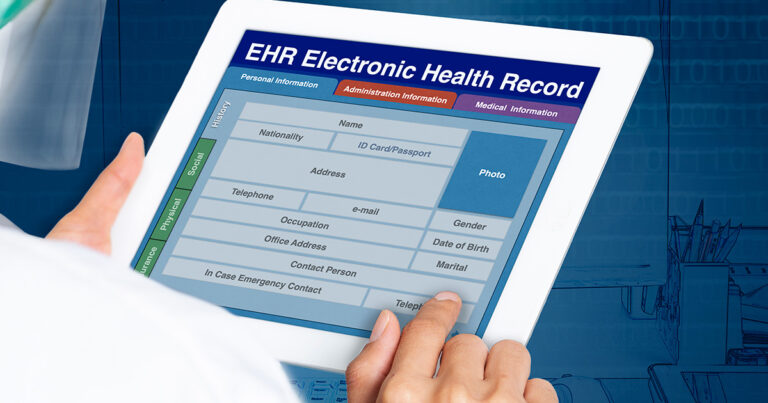What Does the Future of EMR/EHR Look Like for Your Practice?
Electronic Medical Records (EMR) and Electronic Healthcare Records (EHR) have been around since the mid 1960’s, but weren’t fully mandated in the healthcare industry until 2009.
To some degree, the use of EMR/EHR is foundational to modern medicine. As of March 2017, 67% of all healthcare providers reported using EHR, with some reports indicating the number is as high as 87%.
But some experts have pointed out that the technology itself isn’t designed for the future, and it’s far from perfect.
As practices continue to build around these systems, the rise of electronic healthcare isn’t necessarily guaranteed.
For those that have invested (or are in the process of investing) a significant amount of money into EMR/EHR technology, ensuring that it will be around (and successful) for the foreseeable future is imperative.
Here’s what that future could look like, and what it might mean for your practice.

Cloud Technology and Data Hosting
One of the biggest concerns with current EMR/EHR systems is the cost of hosting. According to one study, 45% of providers reported spending more than $100,000 on an EHR system.
While the costs can be worth it in terms of convenience and usability, the trouble for many practices is that upgrading to an electronic system isn’t a one-time event. Technology changes rapidly, and systems must be kept up-to-date over time.
In order to save costs on updating and upgrading systems, many practices opt to use third-party EHR vendors that host data in the cloud.
The cloud allows practices to keep data offsite rather than maintained on their own systems, which can be expensive and time consuming to fix should the system crash.
The use of the cloud is unlikely to change in the near future, as it offers a lower-cost solution for data hosting and sharing.
In fact, some experts predict that IT vendors will begin to court smaller practices with reasonably priced and customized cloud services to host their patient data. There are currently around 1,100 vendors that offer EHR, and that number is sure to increase.
So what does that mean for your practice?
If smaller or mid-sized practices want to keep pace in the growing digital landscape, they should focus on using vendors that offer cloud technology, as well as those that offer assistance and the ability to upgrade technology over time.
Security Concerns for EMR/EHR Systems
Another issue that plagues EMR/EHR is security concerns, even for those that use cloud technology.
One mid-year report published by Protenus revealed that 233 breach incidents were reported to the Department of Health and Human Services in 2017, with the number of patient records affected surpassing at least 3.1 million.
But most troubling is that 41% of those data breach incidents were found to be the result of insiders (office staff and health care providers) either accidentally or purposefully accessing electronic files.
This means that healthcare practices will need to remain vigilant, not only for malware or ransomware that can shut down these systems (choosing a secure vendor will help with this), but also of the actions of their own staff.
This might require some practices to hire a Chief Security Officer (CSO), or to create safety protocols and training for their team members.
Practices will also need to be aware of how patient files are shared between other practices and providers. Just because healthcare information is safe in your office, doesn’t mean it’s equally safe elsewhere.
According to Scott Finley, CEO of MaxMD, care coordination will be a concern for practitioners using EMR/EHR in the future.
His advice:
Meaningful Use, MACRA and Other Regulations
In addition to being aware of technological capabilities (and protection) of the EMR/EHR software itself, practitioners and office administrators will also need to pay special attention to changing regulations that could affect the use of electronic records.
In 2017, the Medical Access and Chip Reauthorization Act, or MACRA, was set to go into effect in an effort to improve the way payments are processed and received by private practices.
But to date, not every clinic is participating in MACRA, and many still don’t understand what it means for their payment processing systems or how to integrate it with their EMR/EHR.
According to Ted Chan, founder and CEO of CareDash.com, “MACRA alone will significantly impact how practices think about EHRs, driving a major reassessment of approaches to EHRs.”
Meaningful Use is another issue that will continue to impact how practices handle their electronic healthcare data.
Over 370,000 providers have earned Meaningful Use incentives, yet one third of providers that have adopted an EHR system report that their system does not meet Meaningful Use criteria.
In order for practices to take full advantage of the benefits of EMR/EHR systems, it will be important to collect key data from vendors about Meaningful Use, MACRA, and any other federal or state regulations that might impact them.

Patient Access to Digital Healthcare Files
Recent changes in U.S. HIPAA regulations also affect how practitioners share access to EMR/EHR files.
The changes in regulations state that if patient records are electronically maintained, those patients have to be given access to their records electronically. This can be seen as both a positive and a negative for some practices.
In certain cases, this means better patient care. Patients who have the ability to access their records (if they choose to do so) have been known to take more proactive steps in managing their health.
But this also creates a problem for smaller and mid-sized practices that need to create online portals for patients to be able to access those files. Some EMR/EHR vendors have the capability to create these portals, but not all.
In order to stay HIPAA compliant, this may mean hiring IT developers to improve website and EMR/EHR functionality, which adds to the cost.
Practitioners and healthcare providers will need to look for vendors or IT specialists that can create patient portals at a reasonable price, and encourage patients to take advantage of their online access.
Nationalized Databases and File Sharing
Another IT trend that healthcare providers will need to be aware of is the growing interest in a national database of patient data.
For example, the U.S. Veterans Administration database maintains data on all active and retired servicemen who use the VA system for their healthcare.
The benefits of a national database include more uniform access to entire patient history, no matter where care has been provided, as well as better patient access to their medical history.
Governments and national healthcare research and development organizations, like the CDC, will also have better access to trends and demographics from such a database.
But while EMR/EHR already creates a more unified approach to the storing and sharing of patient healthcare information, the need for a more centralized database may strain current technologies.
If rulings and regulations for a national database require patient files to be in a certain format, for example, this may mean upgrading or changing vendors in order to meet those regulations.
For practices that already struggle to keep pace with the costs of the latest technology, this could create a burden to remain up-to-date.
This means that practices in the process of updating their current EMR/EHR systems should be aware of any upcoming changes that might affect the systems they are using, and they should ask vendors about future upgrade costs.
Stay ahead of the game! Learn about the 5 hurdles you may face in the future with an EMR/EHR.
Final Thoughts
While EMR/EHR and other digital technologies are the future of healthcare, that doesn’t mean implementing them will be an easy journey for every healthcare provider.
Much of the burden to keep up-to-date with EMR/EHR technology will fall (for the time being) on the shoulders of healthcare practitioners.
But the good news is that the trend toward digital will also create more competition for EMR/EHR and IT vendors, which means more reasonably priced offerings and better technology for small to mid-sized practices.
Practitioners who currently implement EMR/EHR systems will need to be aware of the major concerns that they will face in the upcoming years, including security concerns and changes in regulations (HIPAA, MACRA, etc.).
This will require a continuous dialogue with vendors as well as office staff, patients and other practitioners to ensure that everything meets current standards while also leaving room for growth and change.






